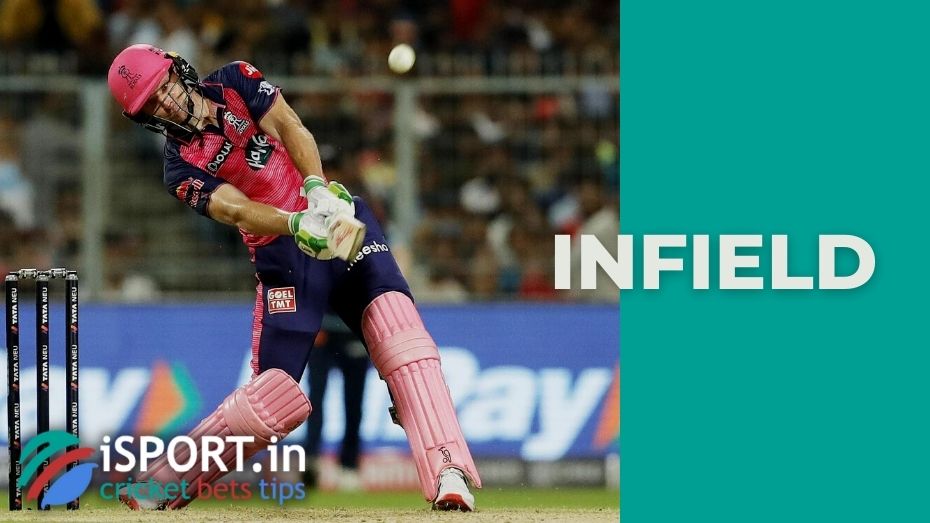Infield

The infield in cricket is the inner area of the field with a radius of 27.4 meters, enclosed in an Outfield ring. This is an area in which the majority of the game’s action takes place. There is a distinction that has to be made between the infield and the close-infield. The second one lies inside the oval infield zone and consists of two circles that cross with a radius of 13.7 meters each.
Infield in Cricket:
Infielders, as opposed to fielders, are required to possess a larger variety of abilities, including quick reflexes, concentration and dexterity. Inother words, infielders are the cricket players who are in the infield in cricket zone during draws. A greater level of expectation is put on infielders since they are the ones who are responsible for making the game genuinely outstanding.
A variety of constraints were put on fielders as a result of the split of the field into two distinct zones: the infield zone and the outfield zone. The main goal is to prevent the game from being unbalanced, which may happen when the fielders assist the bowler in an excessive manner. The positions on the field are decided by the attacking player and the team captain, taking into consideration that fielders cannot walk on or cross the pitch until the batter has touched the ball.
In women’s cricket, for instance, the infield radius is less than in men’s cricket. Field limitations may vary greatly depending on the format of the game as well as the gender of the players. When it comes to Powerplay tournaments, for instance, there are only two fielders that are permitted to be positioned in the Outfield during the first ten overs (assuming that we are talking about an inning composed of fifty overs). There must be at least three fielders remaining on the Off or Leg Side if the inning is restricted to a maximum of 24 overs.
Infield in Cricket: Key points
Apart from the positions of the bowler and batsman, there are several key points in the infield zone, namely:
- The wicket. The position of the wicket-keeper in the infield zone is behind the batsman. However, the distance between them may change depending on the category that the person who is bowling for the opposing team belongs to. As a result, if we are discussing a fast bowler, the wicket-keeper has the ability to move away from the wicket to a distance of up to twenty meters. On the other hand, if there is a spinner in the opposite position, the wicket-keeper should go closer to the wicket.
- The players in this position are located behind the wicket-keeper. Getting a hold of the ball is their primary responsibility. It is possible for four players to shut this zone at the same time; however, captains are only allowed to deploy a maximum of three players.
- A mini-zone that is a continuation of Slips and is located in the front diagonal part closer to the wicket-keeper. The player assigned to it performs virtually the same functions but can bring more benefit if the match is held on a slow pitch.
- Leg slip and Leg gully. Both of these positions are the polar opposites of Slips. Even if the captain makes the decision to utilize this zone, it is quite unlikely that he would send more than one player there since batsmen, as a rule, are able to safely guard it. However, they are not always closed. One possible exception to this rule is when a batsman has a terrible performance.
- Silly point and Short leg. At an angle of 45 degrees, the first position is situated in close proximity to the pitch from the Off side. The second one is across from it (on side). It is the captain’s responsibility to assign a player to the position of Silly point. This person plays a significant part in the offensive operations of the team and may be particularly hazardous for hitters in the event that a spinner serves the ball. This is a potentially hazardous situation that demands a great deal of expertise and a good response from the cricket player. This is because the cricket player should never walk on the field when the bowler is running up to him. Short leg is used more often when there is a fast bowler in the attack. Nonetheless, the player’s role remains the same in this scenario, which is to continuously watch the bounce of the ball and attempt to intercept it whenever it is feasible to do so.
- Silly mid-on and Silly mid-off. As the name implies, these positions are located perpendicular to the wicket line (the first one is right in front of Silly point closer to the side of the pitch on which the batsman is located, the second one is in front of Short leg). As in the previous case, the role of the players closing these areas is to help the spinner, forcing the batsman to make mistakes and intercept the ball.
- Point and Backward point. These points are located one after another on the Off side closer to the edge of the Infield. Their exact localization depends on the bowler’s playing qualities (for example, if there is a spinner in the attack, then the cricketer will move closer to the batsman on Point and Backward point). The task of these players is to intercept the ball on the rebound, so, as a rule, captains put the most resilient and physically strong team members here.
- Cover and Extra cover. These two positions are opposite to the previous ones (they are located one after the other on the same side of the field but closer to the bowler). Often they remain uncovered, especially if the captain is inclined to rely on the bowler’s skill. However, players on Cover and Extra cover can provide considerable assistance to the attack, intercepting the batsman’s blows to send him out faster.
- Mid-on and Mid-off. Specifically, they are situated on the On side and the Off side, which are both placed behind the bowler. It is the responsibility of the players who are positioned in these locations to defeat the batter, particularly if he is skilled at drives. Due to the fact that a great number of blows are delivered via this region of the infield, the positions of mid-on and mid-off are among the most responsible. To a certain extent, this is the reason why the captain selects one of them for himself.
- Square leg and Backward Square Leg. They are on the other side of the infield in cricket from the point and backward point, and they are not too far away from the second referee. Those who play in these places are essential in the event that the batter of the other team is skilled at executing hook and pull strikes. In order to fulfill their responsibility of preventing the ball from leaving the infield, captains often choose physically robust players of the team to fill the square leg and backward square leg positions.
- Mid-wicket. Another position that is located closer to the infield in cricket contour on the Leg side is closer to the bowler. It is considered important and responsible since it is in this zone that batsmen most often hit the ball. Thus, a player in the Mid-wicket position helps the attack and turns the course of the game, especially if the opponent’s batsman cannot boast of a sufficiently diverse arsenal of strikes.
- Fine leg. This position is located behind the Square leg at an angle of slightly less than 45 degrees with respect to the batsman. It is used mainly in cases when a player with a bat prefers risky strikes.
- Fly slip. A player in this position is often called a Short third man. This zone is located behind the Slips right on the border of the infield in cricket and, as a rule, is used as an alternative to them if the team focuses on defensive actions. The player closing the Fly slip must be ready for a large number of moves in order not to let the ball outside the Infield.
This is interesting: Infield in cricket is provided not only on cricket fields, but also on baseball fields and racetracks.
